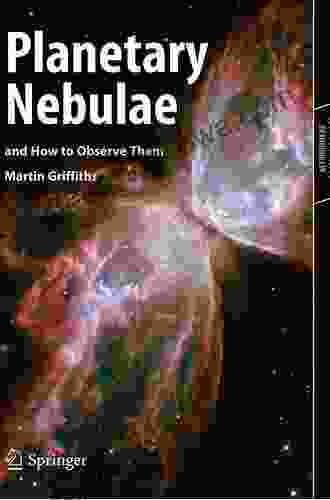Planetary Nebulae and How to Observe Them

Planetary nebulae are fascinating objects to observe with a telescope. They are the glowing remains of dying stars, and they come in a variety of shapes and sizes. Some planetary nebulae are round, while others are elliptical or even bipolar. They can be colorful, with hues of red, green, and blue. And they can range in size from a few light-years to several hundred light-years across.
4.4 out of 5
| Language | : | English |
| File size | : | 12947 KB |
| Text-to-Speech | : | Enabled |
| Screen Reader | : | Supported |
| Enhanced typesetting | : | Enabled |
| Word Wise | : | Enabled |
| Print length | : | 428 pages |
Planetary nebulae are formed when a star reaches the end of its life. As the star dies, it sheds its outer layers of gas and dust. This material forms a shell around the star, and it is this shell that we see when we observe a planetary nebula. The central star of a planetary nebula is usually very hot, and it emits ultraviolet radiation that causes the gas in the shell to glow.
Observing planetary nebulae is a great way to learn about the life cycle of stars. It is also a fun and rewarding experience. If you have a telescope, I encourage you to give it a try. Here are a few tips for observing planetary nebulae:
- Use a telescope with a large aperture. The larger the aperture, the more light the telescope will collect, and the brighter the planetary nebula will appear.
- Use a narrowband filter. A narrowband filter will block out most of the light from the night sky, and it will make the planetary nebula appear more prominent.
- Observe the planetary nebula on a clear night with no moon. The moon's light can make it difficult to see planetary nebulae.
- Be patient. It may take some time for your eyes to adjust to the darkness and to see the planetary nebula.
Here is a list of some of the best planetary nebulae to observe:
- The Ring Nebula (M57) is one of the most famous planetary nebulae. It is located in the constellation Lyra, and it is about 2,300 light-years away. The Ring Nebula is a round, glowing shell of gas that surrounds a central star. The central star is very hot, and it emits ultraviolet radiation that causes the gas in the shell to glow.
- The Dumbbell Nebula (M27) is another famous planetary nebula. It is located in the constellation Vulpecula, and it is about 1,300 light-years away. The Dumbbell Nebula is a bipolar planetary nebula, which means that it has two lobes of gas that extend out from the central star. The central star is very hot, and it emits ultraviolet radiation that causes the gas in the lobes to glow.
- The Helix Nebula (NGC 7293) is a large planetary nebula that is located in the constellation Aquarius. It is about 700 light-years away, and it is one of the closest planetary nebulae to Earth. The Helix Nebula is a round, glowing shell of gas that surrounds a central star. The central star is very hot, and it emits ultraviolet radiation that causes the gas in the shell to glow.
- The Cat's Eye Nebula (NGC 6543) is a beautiful planetary nebula that is located in the constellation Draco. It is about 3,300 light-years away, and it is one of the most complex planetary nebulae known. The Cat's Eye Nebula has a central star that is surrounded by a series of concentric rings of gas. The rings are caused by the interaction of the star's wind with the surrounding gas.
- The Eskimo Nebula (NGC 2392) is a planetary nebula that is located in the constellation Gemini. It is about 3,000 light-years away, and it is one of the most colorful planetary nebulae known. The Eskimo Nebula has a central star that is surrounded by a glowing shell of gas. The gas is colored red, green, and blue.
I hope this article has helped you to learn more about planetary nebulae and how to observe them. If you have any questions, please feel free to leave a comment below.
Happy observing!
4.4 out of 5
| Language | : | English |
| File size | : | 12947 KB |
| Text-to-Speech | : | Enabled |
| Screen Reader | : | Supported |
| Enhanced typesetting | : | Enabled |
| Word Wise | : | Enabled |
| Print length | : | 428 pages |
Do you want to contribute by writing guest posts on this blog?
Please contact us and send us a resume of previous articles that you have written.
 Book
Book Novel
Novel Page
Page Chapter
Chapter Text
Text Story
Story Genre
Genre Reader
Reader Library
Library Paperback
Paperback E-book
E-book Magazine
Magazine Newspaper
Newspaper Paragraph
Paragraph Sentence
Sentence Bookmark
Bookmark Shelf
Shelf Glossary
Glossary Bibliography
Bibliography Foreword
Foreword Preface
Preface Synopsis
Synopsis Annotation
Annotation Footnote
Footnote Manuscript
Manuscript Scroll
Scroll Codex
Codex Tome
Tome Bestseller
Bestseller Classics
Classics Library card
Library card Narrative
Narrative Biography
Biography Autobiography
Autobiography Memoir
Memoir Reference
Reference Encyclopedia
Encyclopedia Kristin Plain
Kristin Plain Lawrence Durrell
Lawrence Durrell Paulo Cachim
Paulo Cachim Krysti Brice
Krysti Brice Oscar Brogan
Oscar Brogan Kostya Kennedy
Kostya Kennedy Kris Deva North
Kris Deva North Peter Thilo Hasler
Peter Thilo Hasler Larry Harmon
Larry Harmon Marci Lyn Curtis
Marci Lyn Curtis Laura Dave
Laura Dave Lisa Mccarter
Lisa Mccarter Tannagh Pfotenhauer
Tannagh Pfotenhauer Leslie Linsley
Leslie Linsley Softcover Reprint Of Hardcover 1st Ed 1992...
Softcover Reprint Of Hardcover 1st Ed 1992... Roger Steen
Roger Steen Nicholas Fox Weber
Nicholas Fox Weber Weatherspoon
Weatherspoon Steven Verrier
Steven Verrier Stephan Anderson
Stephan Anderson
Light bulbAdvertise smarter! Our strategic ad space ensures maximum exposure. Reserve your spot today!

 Edison MitchellWitness the Unveiling of the Untold Tale: The Extraordinary Palio of Siena...
Edison MitchellWitness the Unveiling of the Untold Tale: The Extraordinary Palio of Siena...
 Haruki MurakamiYear Place Value Autumn Term Block: Empowering Teachers, Enriching Student...
Haruki MurakamiYear Place Value Autumn Term Block: Empowering Teachers, Enriching Student... Jerry HayesFollow ·19.9k
Jerry HayesFollow ·19.9k Mason PowellFollow ·15k
Mason PowellFollow ·15k Banana YoshimotoFollow ·17.4k
Banana YoshimotoFollow ·17.4k Nathaniel HawthorneFollow ·14.2k
Nathaniel HawthorneFollow ·14.2k Ian MitchellFollow ·19.7k
Ian MitchellFollow ·19.7k Roy BellFollow ·12.6k
Roy BellFollow ·12.6k Sean TurnerFollow ·6.3k
Sean TurnerFollow ·6.3k Thomas HardyFollow ·4.4k
Thomas HardyFollow ·4.4k

 Langston Hughes
Langston HughesUnlock Your Teaching Dreams with Nystce Mathematics 004...
Elevate Your Preparation...

 Finn Cox
Finn CoxUnlock Your Mtel Music 16 Certification: A Comprehensive...
: Embark on the Path...

 Calvin Fisher
Calvin FisherThe Unforgettable Journey of Self-Discovery in "Out of...
An Extraordinary Journey of Growth and...

 Isaiah Price
Isaiah PriceWhy Am I So Happy Dating With a Bolivian Girl?
I've been dating my...

 Junichiro Tanizaki
Junichiro TanizakiVolume: The Hole Inside the Earth - Discover the...
Delve into the...
4.4 out of 5
| Language | : | English |
| File size | : | 12947 KB |
| Text-to-Speech | : | Enabled |
| Screen Reader | : | Supported |
| Enhanced typesetting | : | Enabled |
| Word Wise | : | Enabled |
| Print length | : | 428 pages |









